The Thinking of the Magi
In order to fully understand the record of Matthew, and the star of Bethlehem, we have to get inside the heads of the Magi. We have to understand their astrological thinking without approving of it or practicing it. Our goal is to show what motivated them, and when it motivated them. If we can show what motivated them, then we can show when it is most likely that they set out on their journey, and how it fits into the overall Biblical Chronology. (The overall scripture chronology is explained in the
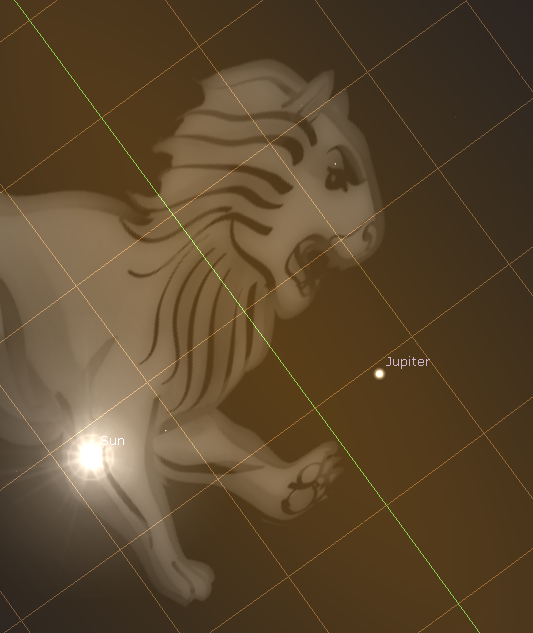 Aug. 1, 3 BC
Aug. 1, 3 BC
Astrologers come up with endless stories of astronomical alignments, positionings, symbolisms, and calculations, to tell their deterministic tales and myths about the stars influencing the lives of men. The practice is utterly forbidden in the Scripture. Our object is to explain this kind of thinking in the case of the Magi, and how it got into the book of Matthew. Mathew, of course, is only reporting the historical facts surrounding the visit of the Magi. He is not approving of their art. Astrologers can come up with virtually any tale or prognostication when you put them in front of a star chart. It is the sort of thing that drives real astronomers nuts, because it is so utterly unscientific, and superstitious. For the most part of the history of nations with a non-Christian world view, the art of astrology, and the science of astronomy, have been mixed up together. And both types of men worked together. We cannot therefore condemn all the Magi as true pagans. Some of them were schooled in the arts of astrology without actually believing in the efficacy of the art. And there were always legitimate astronomy positions attached to the astrological schools. Astrologers were also a disagreeable bunch. They had many internal disputes, which they kept away from the public. Ancient astrology needs to be judged separately from the modern practice. Modern astrology has been driven out of the domain of astronomers due to the influence of Scripture. Therefore, modern astrology took most of the corruption with it, and left the science with the astronomers. There is still a great degree of corruption in the astronomical discipline, and this is in the department of cosmic evolution.
 Aug. 1, 3 BC
Aug. 1, 3 BC
The Magi were studious watchers of the planet Jupiter. It was one of the brightest planets. In their vocabulary is was a star. And it was more than a star. It was a special star that moved in a 12 year cycle while doing neat loops back and forth as it moved. When it disappeared behind the sun, it was said to die or be consumed in the fire of the sun, and when it reappeared rising out of the sun, it was said to be reborn. This latter event is what is called a
The plain message is, a powerful king is born in the lion. Now the standard biblical symbol for the tribe of Judah is the lion. There is another reason to suppose this helical rising is the point where the Magi first started to connect their interpretations to the Jewish Messiah. Herod had asked them when the star first appeared. They answer is given only indirectly by Matthew. Herod murdered all the male babies in Bethlehem, “from two years old and under” (NAU). This translation, though, is somewhat misleading, as it seems to indicate a child of 2 years and 10 months might be included. A better translation is “from the second year and under.” The Greek, διετοῦς means “the second year.” The word is not plural in Greek. That is a mistake. Also there is no word for “old” in Greek. Literally, “from two-year and under.” The question is whether “two” should be taken in the ordinal sense or the cardinal sense. The cardinal number is ordinarily δύο. The ordinal is δευτέρᾳ. What we have in this text is δι. δίς is used to mean double or twice. For example, διπλως means twofold or double, and δίλογος means double-tongued,
 Aug. 1, 3 BC
Aug. 1, 3 BC
I have to conclude that the phrase means any male child from the age of 24 months or less. Now the slaughter of the children occurred on December 30, 2 BC, or that day, and a few days afterward. (The low estimates of the number of murdered children start at 7. The incident was passed over by Josephus in light of the fact that Herod planned to murder thousands of Jewish nobles not long after this.) The helical rising of Jupiter in Leo occurred on August 1, 3 B.C. The space of time from the appearance of the star is therefore 18 months. Herod knew he was looking for a child that was not more than 19 months old. The murderous decree therefore is for 24 months and less. The extra 5 or 6 months is just to make sure. And not only did Herod kill the children in Bethlehem, but he also killed all the male children meeting the criteria in the countryside around the town. Again, just to make sure. It is unlikely that the number was more than 50, which would imply a population of more than 2000 inhabitants in the town and surrounding countryside. Albright estimates the population of the town itself at only 300.
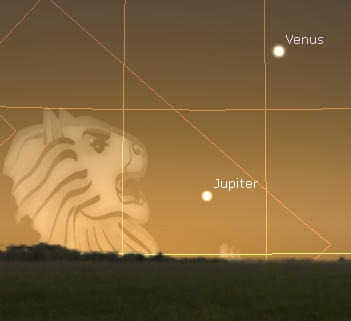 Aug. 1, 3 BC
Aug. 1, 3 BC
Herod “determined from them the exact time the star appeared” (Mat. 2:7). This means the star cannot be seen before the date, and then is seen after the date. The helical rising of Jupiter qualifies perfectly. It had been gone from view from about June 26th, and it reappeared on August 1, 3 BC. The green line cutting through the image between the sun and Jupiter is the horizon line. The sun is below it. I will now include a shot with the below the horizon filled in, to give a better feel of a helical rising. Also I will level out the horizon for a non-telescope view. At the right is what an earth bound observer would see. The red line between Jupiter and Venus is the constellation boundary line. The landscape is Guéreins. “Guéreins is a small French village in the Valley of the Saône river, 50 km North of Lyon. In the west stand the small mountains of the "Beaujolais" where the famous wine is produced. It is also the town where Stellarium was born” (Stellarium 0.13.1). For the actual location of the shot I picked a place in SW Iran, which is near enough to the home of the Magi.
We may conclude then that the helical rising of Jupiter on August 1, 3 B.C., fits the time line exactly. It explains why children 24 months or less were murdered. The symbolism fits the notion of a royal birth in Judea. Probably, the Magi were building several astrological interpretations, and debating among themselves the merits of each. The fulfillment of astrological omens is at best superstition of the influence of the stars, and happenstance. People can be really deceived by happenstance if they have that sort of deterministic philosophy of the world. At worst, the devil and his evil spirits get involved, and make little things in the lives of people actually happen according to the prediction of their local astrologer. But doing this the devil encourages a misplaced faith in the stars. The astrologers themselves also enhance their deception by using the language of perhaps and maybe such and such will happen. That way they are off the hook if nothing happens like they predicted it. Superstitious people are much more likely to remember when something appears to happen according to the prediction then they are to remember all the failures. No one likes to remember a negative. Its all a big game of deceiving and being deceived.
Then there is the Almĭghty in heaven to reckon with. He never promised never to play games with the heads of astrologers himself. And there is a precedent for this sort of thing from heaven. If we remember the medium that king Saul wanted to consult, we find that the Almĭghty intervened in that case and instead of letting the medium impersonate an evil spirit, He raised the actual prophet out of his sleep and gave him one last prophecy for the king. Then there is the time that Yăhwēh wanted to put Ahab to death, and therefore he suborned an evil spirit to lie to Ahab’s prophets. In the case of the Magi, it appears that he is having some sympathy for them, and is going to use their deceptive art to point them in the right direction. And they did head in the right direction. So we will look at the events and thinking that got them going that way. And we will even allow the Almĭghty to have a hand in arranging things just so for the birth of his Sŏn. We are allowed to see what was done historically after the fact, and to inquire into the reasoning of the Magi. However, it is utterly forbidden to use this astrological art to even speculate about the future, or to speculate about the influences of the stars of the lives of people.
The sun, moon, and stars are for setting the appointed times, as described in Scripture (Gen. 1:14; Lev. 23). Therefore we can calculate them, forward, and backward. We can observe the signs of the appointed times. It is not allowed to use them for anything but setting time. The language of astrology and astronomy use similar terms, but they use them for completely different purposes. I have seen time and again Christians starting out with the legitimate use of astronomical signs for timing, and then diving off into their own astrological interpretations. They need to be jolted that they are falling from legitimate science into forbidden superstition. We need to keep clearly in mind that making a good estimate of what the thinking of the Magi was, it in no way legitimizes their thinking. The Magi were a mixture of astronomically minded individuals and dabblers in astrology. We know little about their knowledge of the true Gŏd either before or after their trip to see Mĕssiah. One only like to think that some of them woke up and got onto the right track with heaven, and obtained a faith in what is really true, than to have continued in superstition, through their experience, as recorded in Matthew. We simply do not know. However, it does appear that they were royally used at this time by the Almĭghty, if for no other reason, than to shock a spiritually lethargic Jerusalem into wakefulness.
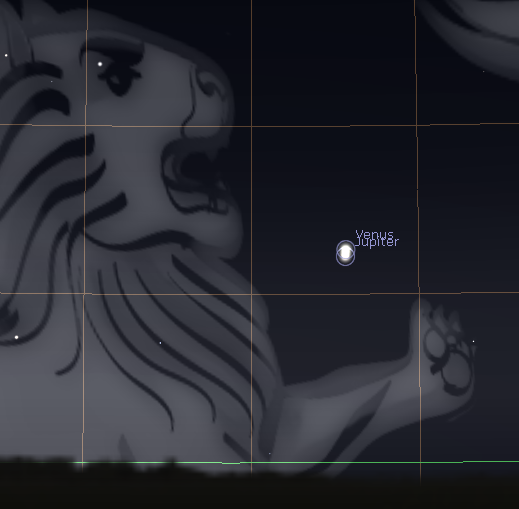 Aug. 12, 3 BC
Aug. 12, 3 BC
What does this conjunction mean to the Magi? See image at the right. We can see that this happens in the constellation of Leo. Venus represents a woman, or a mother to them, or the mother of the gods. And Jupiter is the king of the gods, or the king planet. One wonders where the Magi picked up the notion to worship Mĕssiah. Was it from reading messianic prophecies that he would be “Gŏd with us” and the “Mighty Gŏd”? Or was it from their astrological arts? Did they prognosticate a divine birth here, the king of the gods conjuncting with the mother of the gods, in a sign of the lion, standing for Judea? This is the sort of thing to get the mind of an astrologer in gear. And it might be highly motivating to them if they had the book of Daniel. Possibly Daniel had left a copy for the Magi 5 centuries earlier. Perhaps they had read Daniel 9. This does not mean that they had to have faith in the book of Daniel. The Magi in the Persian court certainly came to respect Daniel greatly. If then their astrological arts began to concur with the approximate timing in Daniel, they they would be doubly motivated.
Of course, to us, an ordinary conjunction means nothing in terms of human events or prophecies. Such a notion is superstition. Likewise the sign it occurs in means nothing more than to mark the region of the sky where the conjunction took place. However, it does appear that the Almĭghty is just for once gaming them with their own system of interpretation. We can’t say he will never do this again, but we should never try to play the astrologers side of any such game, other than to understand how they have been gamed after the fact, if the Almĭghty should actually admit to a role in it. In this case, I will only say that their appears to be strong circumstantial evidence that He had a role here. But there is no plain admission of it either. What I suspect is that part of that role may have been in jarring the thoughts of the Magi in the right direction. Left to themselves, they might come up with any random interpretation.
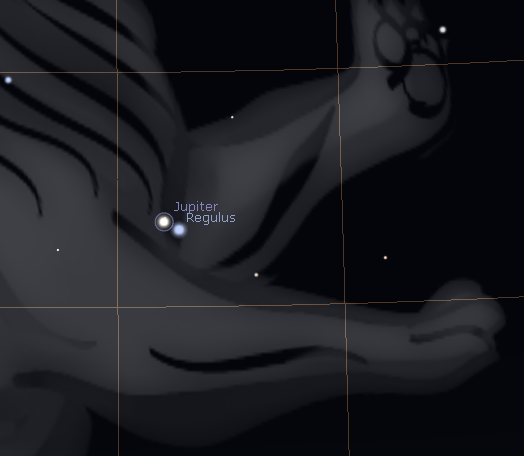 Sept. 14, 3 BC
Sept. 14, 3 BC
The next thing that might have caught the notice of the Magi is this Jupiter-Regulus conjunction on September 14th, 3 BC. Regulus is the “king star” in Leo. The king planet meets the king star, which is conveniently between the legs/feet of Leo. If the Magi were scrambling to find a Scripture text for this one they would find Gen. 49:9-10, “Yehūdah is a cub of a lion; from the prey, my son, you have risen up. He has crouched down; he has lain down like a lion, and as a lioness. Who will make him stand up? The staff‡ shall not turn aside from Yehūdah, and one making rules from between his feet past that time he will come who belongs¹ to †it, and to him is the obedience of the peoples” (notes here). The passage is messianic, and speaks of Yĕshūa̒. After this conjunction Jupiter wanders away from Regulus.
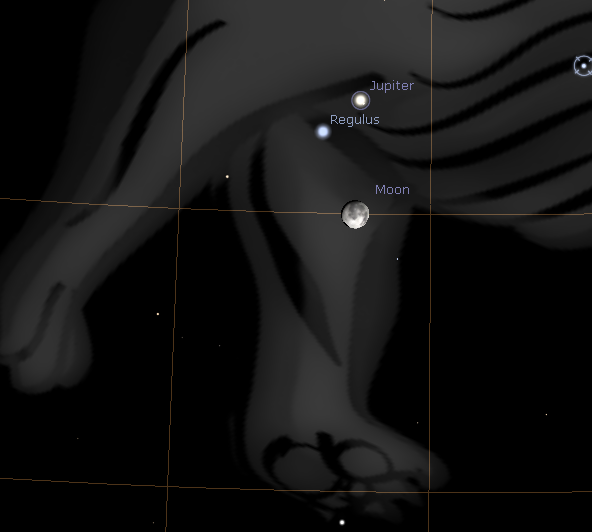 Feb. 17, 2 BC
Feb. 17, 2 BC
About 5 months later Jupiter has wandered back to Regulus. But in the meantime, the moon covers Regulus on Nov. 27, 3 BC, and then the moon covers Regulus again on Jan. 20, 2 BC. These are called occultations. Then on Feb. 17th, 2 BC. Jupiter again is in conjunction with Regulus. Again we have the king planet lining up with the king star, between the feet (or legs) of the lion. It should be noted that the Hebrew word for feet also means legs. The lion is pointing down in the sky at this shot, so what you are seeing is the front legs. Basically, to the Magi, this is a repeat of the same message since the helical rising of Jupiter.
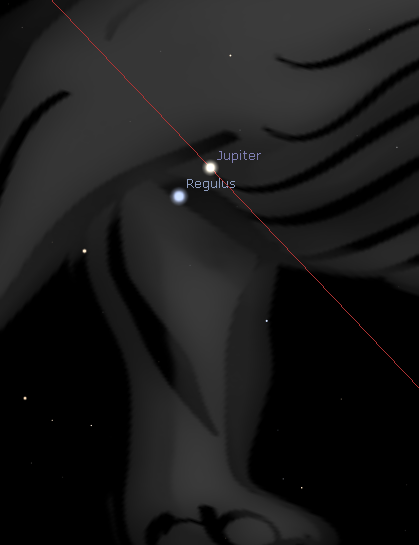 May 8, 2 BC
May 8, 2 BC
A third time Jupiter and Regulus are in conjunction on May 8, 2 BC! The series of three conjunctions with Regulus and Jupiter completes a relatively rare triple conjunction. The king planet with the king star, and between the legs of Leo. Any Magus that is not making king predictions at this point is not worthy of the art. But the show is only getting warmed up. What is going to come next is something the Magi have never seen in their entire lifetime. And it hammers the point home. It is a spectacular conjunction of Jupiter and Venus on June 17th, 2 BC.
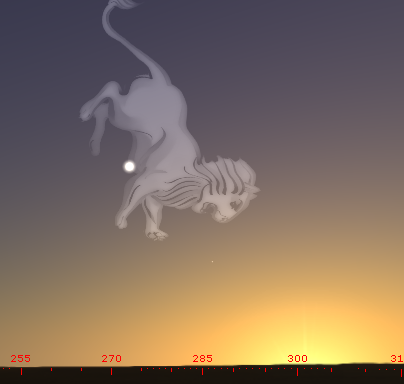 June 17, 2 BC
June 17, 2 BC
Jupiter and Venus come so close together that they appear to merge for the observer. The message cannot be ignored. The mother star (Venus) has met the King Star, Jupiter, in Leo the Lion. A royal birth is imminent in Judea. If the Magi have not packed their bags onto the camels by now, they are busy doing so, and busy making plans to go and check out what is happening in Judea. I have taken the shot here just after sunset, and Stellarium 0.13.1 shows that the double star appears before any other star comes into view. Jupiter’s extincted magnitude is (-1.34 to -1.11), and Venus (-4.00 to -3.77). It would be absolutely the brightest object in the sky. And wherever Magi were posted in the Parthian Empire, which was quite vast, and who saw it, the news of this conjunction would be sure to be newsworthy. The were almost certainly watching the approach at this time, having been alerted by the previous signs.
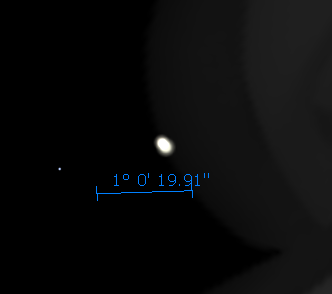 June 17, 2 BC
June 17, 2 BC
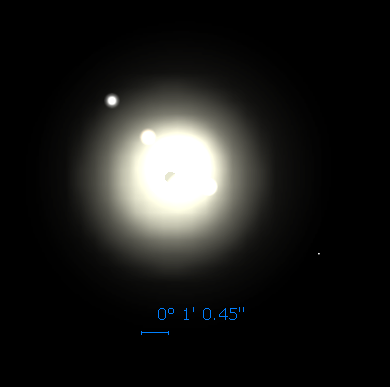 Scale: 1 arcminute
Scale: 1 arcminute
Let’s zoom in on this conjunction, and see what is really going on. I have put up the angle measure at a 1° span to show how close up we are under the belly of the lion. The double star is still a merged blob. That other star off to the left of the conjunction? That is ρ
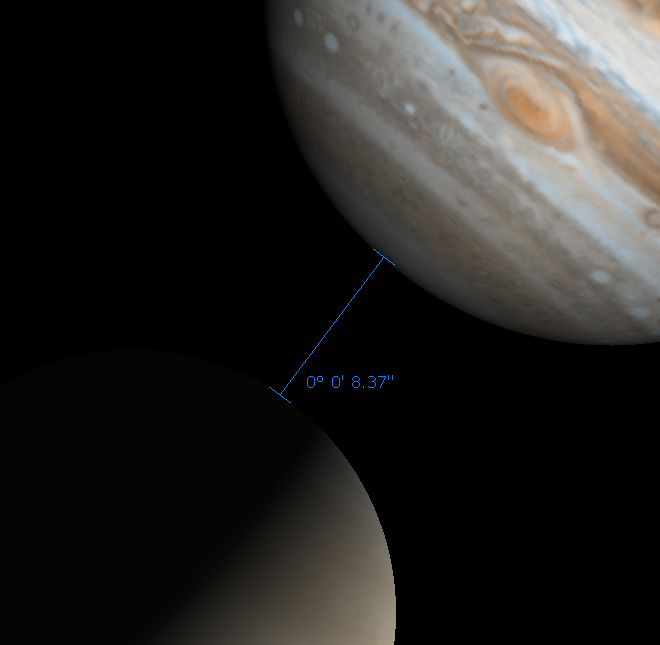 June 17, 2 BC
June 17, 2 BC
So lets get closer with the software, and see the separation distance. Ok, that distance between the two planets is 0° 0' 8.37"! Eight arcseconds is 2/1000ths of one degree. Other noteworthy facts here. Jupiter stands at a distance of 6 AU. And Venus 0.6 AU. That means there is at least 5 AU between the planets. Jupiter is 5 AU behind Venus. An AU is an astronomical unit, or about 93,000,000 miles. So what is 5 AU? Five AU is 465,000,000 miles. Yet in a telescope, they would look like they were right next to each other. The relative diameters of the two planets are nearly the same because Jupiter is so much larger than Venus. What we have seen so far is the helical rising of Jupiter on Aug. 1, 3 BC., the first conjunction of Jupiter with Venus, a triple conjunction of Jupiter with Regulus, along with two occultations of Regulus by the moon, and then this is bookended by an amazing repeat of the Jupiter Venus conjunction, only so close that the human eye cannot tell them apart. And all of this is happening in Leo the Lion. Both Jupiter-Venus conjunctions are in Leo. The tribe of Judah is represented by the Lion. This was certainly not lost on the Magi. The king planet was now Mĕssiah’s star in their way of thinking. And perhaps just this once, the Almĭghty had indulged them in their illicit trade.
If so, then he used the standard meanings, just once, so far as we know, to send a message to the Magi. That does not justify us making up any messages of our own using the symbolism to make predictions. The message is already in the Scripture, about who Mĕssiah is, and when and where he was born. And that can be determined without the astrological side of the symbolism. Only the astronomical side of the terminology is needed. But there is more to come. Surely by this point the Magi have set out, some six months before they are due to arrive in Jerusalem. It took Ezra 4 months to come from Babylon to Judea. If the Magi are from further east in the Parthian Empire, than an extra few months might be required. Of course, they would be busy making their observations of the skies on their journey. They would be rising early and turning in late, so that they could continue to observe, and continue to keep records. By this point, they are debating about when the birth is to take place. Was it when the helical rising of Jupiter happened? Was it when Jupiter first met Venus? But then the king announcement is made three times! Was the first time a conception? Or was it all just a sign of what would shortly happen? A few of the Magi may be mum on the matter, and virtual agnostics. But they still want to check it out. The younger Magi, perhaps have theories, and are tasked with astronomical duties, and have yet to find out the hazardous nature of astrology.
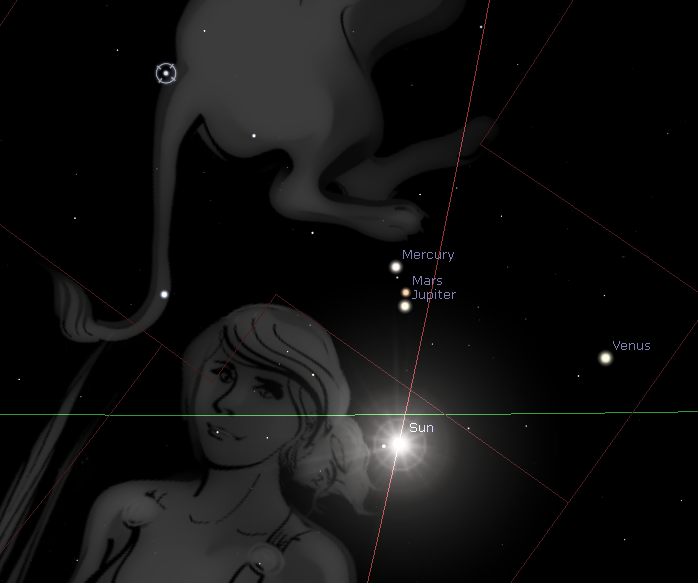 August 25, 2 BC
August 25, 2 BC
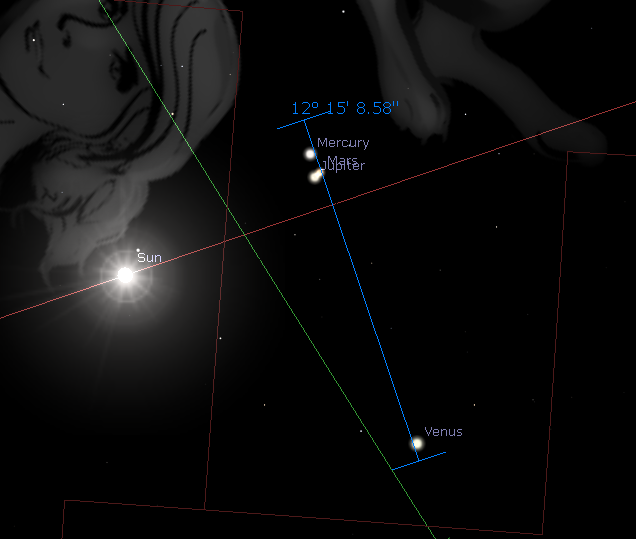 August 26, 2 BC
August 26, 2 BC
The Magi would not be able to see this scene. But their science and calculations were good enough to know that it was happening. The only bodies that they knew about were, the Sun, the Moon, Mercury, Venus, Mars, Jupiter, and Saturn. Everybody is present in this shot except the Moon, and Saturn. When is the moon going to come along? The moon comes along on Aug. 31st. Saturn is absent because it just wasn’t there, and Gŏd wasn’t concerned about it being there. The Magi may have had their own astrological reasons. By the time the birth of Mĕssiah comes, all the plants are strung out. In the image below, Venus at the bottom, Jupiter, Mars, Mercury, then the Sun, and then the sliver of the Moon (5x) here for the new moon day, Tishri 1. I have put the angle measure across the ecliptic to show the line up. This is quite interesting less than a week before his birth. Notice that the line up seems to be the last announcement. Perhaps that is what the Magi considered it after they found out the actual date of birth form Miryam. You can be sure they asked. They were all dying to find out. What interpretation would they put on it with the 20/20 hindsight of knowing the birth date? We can only speculate. Perhaps they thought that the line up between Leo and Virgo was the last announcement of the birth of a king. Mercury makes it a message. Mars seems to indicate that war is coming (there was a war the next spring). Jupiter is again in conjunction with Venus, so the birth is about to happen. And all the planets are headed for Virgo, except for Venus, which is about a few weeks from turning around and heading back in the direction of Virgo. It is all speculation what they thought here. And whatever they thought, they were coming, and their thinking got them coming.
Yōm Terūah
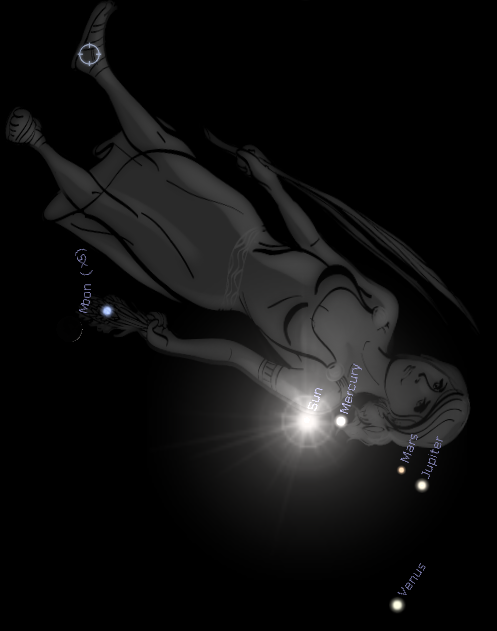 Yĕshūa̒’s Birthday
Yĕshūa̒’s Birthday
Our next image is not speculation, nor is the interpretation of it. And the Magi would not have known the correct interpretation until they learned when the birth was. The event is preserved in the book of Revelation for us as an astronomical synchronism: “And a great sign appeared in heaven: a woman clothed with the sun, and the moon under her feet, and on her head a crown of twelve stars, and she was with child; and she cried out, being in labor and in pain to give birth” (Rev. 12:1-2). The orientation of the image is altitude-azimuth, i.e. regular up and down and sideways direction for viewing from the surface of the earth. The moon is directly beneath the legs or feet on Tishri 1 here. Tishri 1 is an annual Sabbath in the Scripture. John is not giving an astrological interpretation here. He is giving an astronomical synchronism dating the time of the birth. He does use the same terms that astronomers and astrologers would use. The astrologers do not own the terms. An astronomer talks about the constellation of Virgo to locate objects in the sky. Saying that Virgo is clothed with the sun is simply taking literary license to say that the sun is located in that constellation. Locating the moon under the feet is a way of stating the approximate coordinates of the moon before there was an agreed upon coordinate system. If the constellation is a Virgin, then all the better. John is not predicting anything by this fact. It certainly illustrates the truth. In the left hand of Virgo is a bunch of grain or seed. This symbol is messianic, because the seed of the woman was to be the Mĕssiah. The bunch of grain can also be regarded as first fruits. In the right hand of Virgo is the Branch. This too is a messianic symbol. The “Branch” stands for the Mĕssiah, as is mentioned in Zech. 6:18.
about to give birth
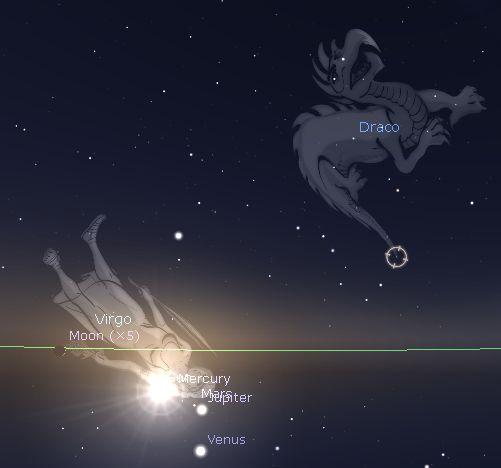 Aug. 31, 2 BC
Aug. 31, 2 BC
The astronomical correlations do not seem to end with Rev. 12:1-2 though. Notice vs. 3-4, “And another sign appeared in heaven: and behold, a great red dragon having seven heads and ten horns, and on his heads were seven royal crowns. And his tail swept away a third of the stars of heaven, and threw them to the earth. And the dragon stood before the woman who was about to give birth, so that when she gave birth he might devour her child.” The text only requires the dragon to be in front of the woman, or “before” her. Indeed, the face of Virgo is looking directly at the dragon, as she labors to give birth. The dragon waits across from her, ready to pounce as soon as the child is born. The Dragon is the devil, and he took his first swipe as Mĕssiah by trying to use Herod to find him and murder him. But he was saved the night before Herod’s soldiers arrived, and escaped to Egypt. The dragon is standing, by the way, indeed, almost rearing up on its hind legs. Its eyes are looking straight up at the zenith of heaven, as if it is coveting the throne of Gŏd.
of Jupiter
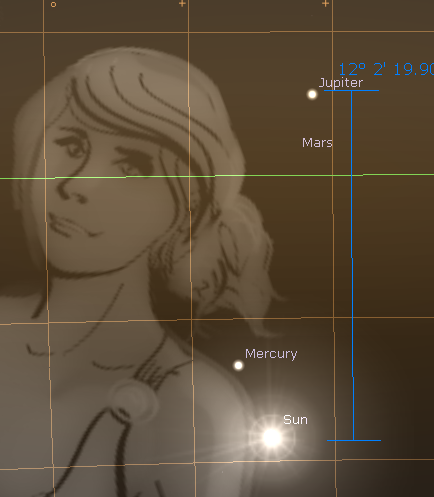 Sept. 1, 2 BC
Sept. 1, 2 BC
What is it next that catches the attention of the Magi? Somewhere around July 25, Jupiter disappeared behind the sun. Maybe the Magi did not know what to make of this. Astrologers do not commonly build interpretations on things that have to happen twice. They just look for one set of alignments, and then they do their prediction, with the usual subjunctive language. Anything more elaborate is bound to spell trouble with the inquiring public who might see the fraud. So they waited for Jupiter to reappear. After all this was the key planet to all the signs they were watching and interpreting. When was “His star” born out of the fire of the Sun? It met the standard definition for the helical rising on 9/1/2 BC, which is but 11 hours after the sign in Revelation 12:1-2! So was Miryam in labor for 11 hours? I hope some messianics do not get too worked up about the sun metaphor here. The Psalmist uses it, “For a sun and a shield is Yăhwēh Almĭghty!” (Psa. 84:12). I think that with some people who think they know the true Gŏd and don’t, that they have a hard time telling when a false one is around or not, and then they are bound to start accusing the innocent of idolatry.
I illustrate the birth of Mĕssiah here with the helical rising. It is remarkable that such an illustration is ready at hand to pick up on the morning of Tishri 1, 2 BC. The Magi would have seen it as predictive. It would have been among their theories of an actual birth date. They would have recorded the helical rising for sure. When they were informed of the birth date, they would have felt their art was justified. On the other hand, it is only justified insofar as Gŏd is actually playing a game with them. Perhaps some of them woke up to this fact when they realized what was going on “this time” put all their other astrology to shame.
This doesn’t mean that a helical rising means anything prophetically or just because Gŏd may have arranged a couple for Mĕssiah that he ever will again. Those who look for correlations in the past, and then try to use them to predict the future, when the stars themselves don’t actually cause anything to come to pass, but only Gŏd does, are playing a dangerous game. Actually, they are acting like astrologers. Take the whole blood moon tetrads for instance. There was a set in 1949-1950, though I often hear them claiming this set goes with Israel’s 1947 becoming of a State. Not an exact correlation. Then there was another set around 1967, but then again no exact correlation with the six day war. I don’t think there is enough evidence to say there was a past correlation at all. And even if there was (as seems to be the case with these helical risings), this does not give us permission to act like astrologers by trying to factor such coming astronomical events into some kind of prophetical scenario, as if they somehow make it more probable! That is nothing but the same superstition as astrology.
There are reasons to think that the end will come in the year of Jubilee. I can’t say which one. But those reasons proceed from reasoning about direct statements in Scripture related to the Jubilee. We can indeed figure out when the year of Jubilee is, and then figure out at which points the end can occur to fulfill the relevant texts. Some cyclical calculations are required. But then someone comes and tries to say that their theory XYZ is better or more probable because it happens to agree with a lunar tetrad, then they are thinking the same way as astrologers, and they are either being gamed by Gŏd, the devil, or are being deceived by some nasty coincidences. These people who do biblical prophecy mixed up with astrology have no skill in solving historical problems of biblical chronology. They are too busy wanting to amaze the public with their prognosticatory skill.
Rising
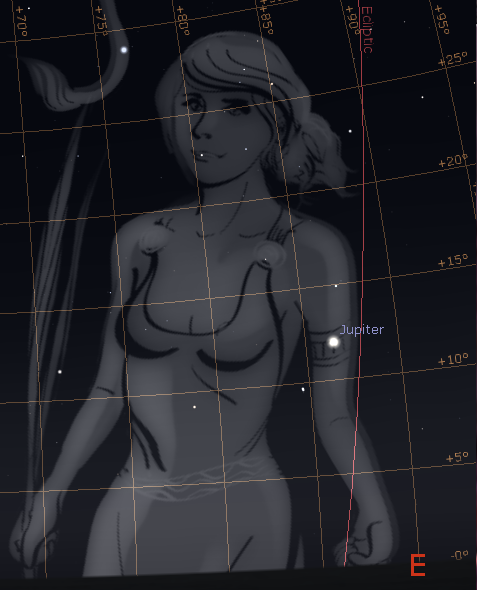 And in the East
And in the Eastἀνατολῇ
The Magi said, “We saw his star in the rising,” but these words can also mean, “We saw his star in the Branch.” It just so happens that the word used is ἀνατολῇ. And the same word is used in Zechariah 6:12 for the “Branch.” The connection is not just a passing mistake in the LXX. The word is used in Ezek. 16:7 also, for the Hebrew word צֶמַח. The Lexicon gives the meaning of the Greek word as, “growing, branch, sprout” (LSJ). The connection between the two definitions might be explained by the term “riser.” When a branch springs up, it is a riser, or rising. Notice then the slender “riser” or “rising” in the right hand of Virgo (at the left in the picture). A connection between the two senses can also be made in Hebrew. The term צֶמַח tsemaḥ may also mean “shine forth” (BDB). Luke 1:78 uses the term, “ἀνατολὴ ἐξ ὕψους,” and should probably be rendered, “The Branch from on High.” The Theological Wordbook of the Old Testament comments, “But in Luke 1:78 with its ἀνατολὴ ἐξ ὕψους the equation of ṣemaḥ YHWH is complete. Therefore we translate the verse, "Because of the tender mercy of our God by which the Branch from on High shall visit us." The only change needed is to convert the term “height” into the divine name and the OT expression appears again.” The Magi called Jupiter “His star,” and then they come declaring, after the second helical rising, that they have seen his star in the Branch.
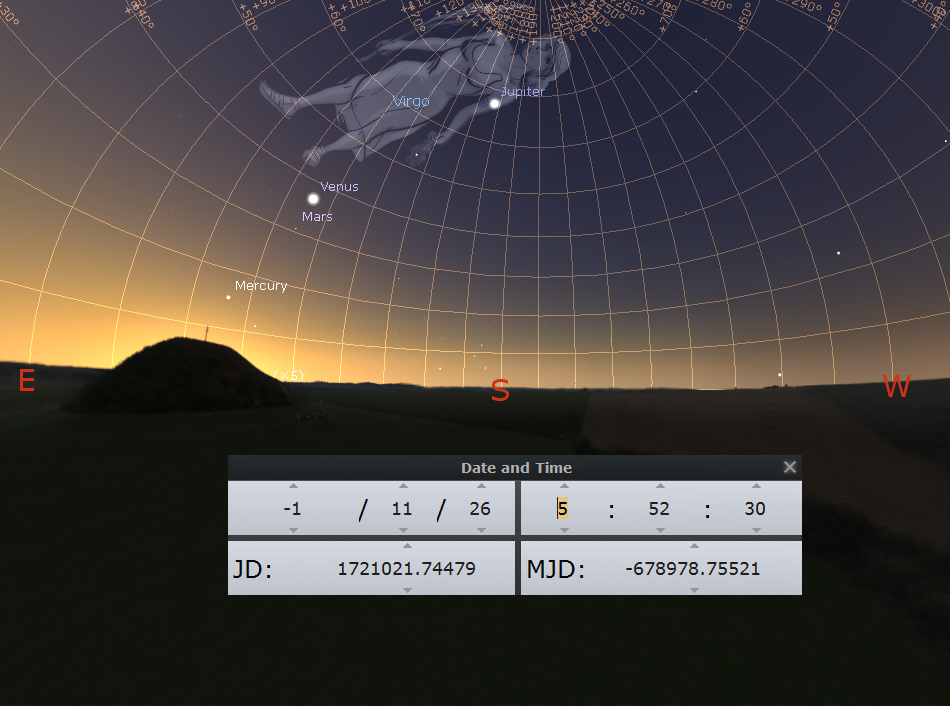 Heading South Nov. 26, 2 BC
Heading South Nov. 26, 2 BC
When the Magi turn south to go down the coast toward Jerusalem, about a month before their arrival, the scene at the right greets them each morning. Just as they are finishing up their last morning observations, Jupiter stands overhead in the south, right before them, in their direction of travel. For at least the last part of their journey then, the star truly does go before them. At almost the same time before dawn on 12/15 the star is bearing 215° just west of south. They are still heading out each morning in the direction of the star. In another shot below, I show the day they left Jerusalem, after inquiring of the learned men in Jerusalem where the Mĕssiah was to be born (see below Dec. 28, 2 BC). They are very eager to get going, and so the scene I show is an hour before the Nov. 26th scene. The star is directly in the direction of Bethlehem heading out south from the city for about 5 miles. The star vanishes in the rising dawn, and they come to the town, perhaps around midday and begin their search. They would have also seen Venus with the star Spica in the sheaf of grain (or seed) between Venus and Jupiter. Maybe they saw Mercury too.
The star was also “going before them” in another sense. The term is “prograde” motion.† This means that the star was moving among the stars in the normal easterly direction. The Magi would have noted the first and second stations of Jupiter. A station is the point at which the planet stops, turns around, and then moves in the opposite direction, either prograde or retrograde. Archaeologists have unearthed whole tablets from Babylonia detailing these stations of Jupiter. And the records are of an amazing accuracy. The calculations give dates for the stationary points which are good to an accuracy of 1 arc minute.
“And hearing the king, they went away, and behold, the star which they had seen in the rising, had been proceeding before them, until coming it had stood above where the child had been” (Mat. 2:9).
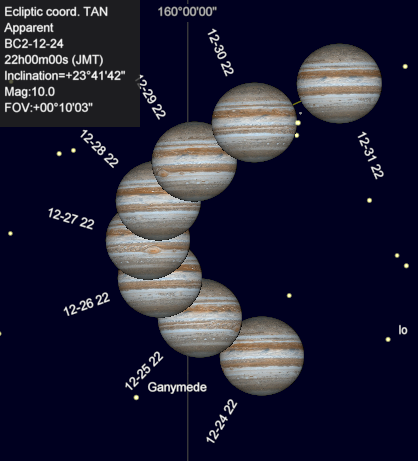 Dec. 27, 2 BC
Dec. 27, 2 BC
The star they had seen in the [helical] rising, and ever since that time on 9/1/2 BC the star had been going before the sun in prograde movement against the background of the stars (west to east), until it came to a stationary point. The text seems to imply that the stationary point was reached before they found the child. The Maji may have calculated the exact time of the stationary point. But we must allow them to be inaccurate to the degree of one arc minute in their selection of a precise time. The range inside 1 arc minute of error is the 25th, 26th, 27th,
From the scientific point of view the most parsimonious time is 12/27 @22:00 hours. I would say that one could judiciously call the whole period from 12/26 @22:00 to 12/28 @22:00 the stopping point. Jupiter is 37 arc seconds in diameter, and in these three easternmost positions, there appear to be only 3-4 arc seconds of difference, between a 10th and 1/6th the width of Jupiter. The text only says, “until it stood above where the child had been,” and the only time restraint here appears to be sometime after they finished talking with king Herod, which I would say was before 10pm on the 27th, which is the precise stopping point. It is most likely that their audience was during the daytime of the 27th, and not after sunset. Although Herod may have summoned them and spent some of that time secretly inquiring about when the star first appeared. And they would have given him the date for the first helical rising.
One hour before Dawn
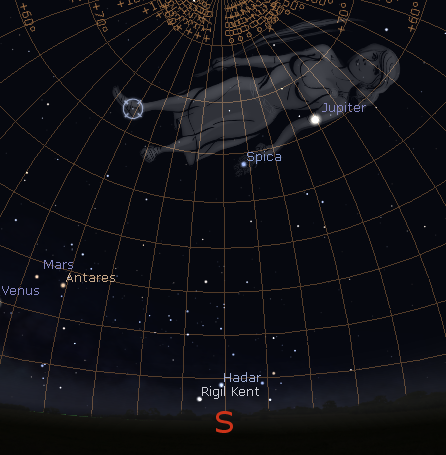 Dec. 28, 2 BC
Dec. 28, 2 BC
In the hour before dawn, after the planet has stopped its eastward movement among the stars, the Magi rise and make their morning observations before setting out for Bethlehem that day. The planet lies in that direction, just a little west of south. The town is five miles away, and so their caravan sets out, perhaps reaching the place around noon. They begin discretely asking. But no one gave them any hints. Apparently the locals didn’t like Herod at all, and were not about to say who the messiah was. One of the farmers even came and quietly said that anyone claiming to be a king other than Herod would shortly loose his head. The politics of the situation finally dawned on the Magi. Their search would be difficult. Really, was Herod such a bad guy. Perhaps these local yokels just had a grudge. Of course the Magi did not know all the rumors about Herod.
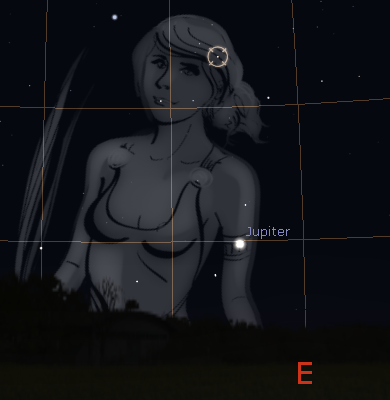 Dec. 28, 2 BC, 10 pm.
Dec. 28, 2 BC, 10 pm.
The Magi decided they would lodge at the inn for that night and figure out how they were going to find the Mĕssiah without disturbing the peace or spooking the skittish locals. He was supposed to be born in Bethlehem. Surely his parents did not leave so soon after the birth? One of the younger Magi went outside about 10 p.m. to make observations. A mysterious stranger walked up to him and said, “I know what you are seeking. Do you see that star just risen in the east? There is a house just to the left of it.” The Magi said, “Yes, ok.” The stranger continued, “You are following that star. Now you will find the right house just where that star has risen on the east side of town, to the right of the house you see, and a few hundred yards beyond it. Go quickly.” The Magi ran and got his fellows. They found the house right under the rising Star, the star they had been following all along.
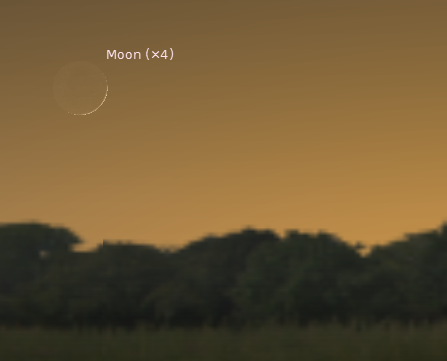 Dec. 28, 2 BC, 6:40 pm
Dec. 28, 2 BC, 6:40 pm
The stranger was no where to be seen, and was quickly forgotten in the excitement of a place to check out. Earlier that evening the Magi had noted the new moon in the west. They found the place, and asked if the Messiah was there. Yōsef said, yes this is the place. How did you find us? They answered. The star up above and pointed to it. When they saw the child they bowed low in worship, and presented their costly gifts. They they feasted the family all that new moon day. The house was too small for them, so they lay down in the inn that night, and dreamed a dream, and they dreamed that they should not go back to Herod to tell what they had found. They returned in the morning and served the family a noon feast, and they were careful not to spread any news to the other locals. After the feast, they left for their country by another road. Early that night, the night after the new moon day, Yōsef dreamed. In it he was told to flee to Egypt at once. That night they fled with the gifts and the child.
Epilogue
There is indeed some speculation in my reconstruction of events here. It’s purpose was to show that the Scripture can fit into a reasonable storyline and reasonably fit the scientific and chronological facts. Where I have speculated, and will be wrong, you can be sure that the truth is even more reasonable. I have set things up with the new moon day, because that is an appointed time according to the Scriptures. And the new moon day did immediately follow the day after the star had stopped its eastward movement in the heavens.
Most Christians seem to believe that the star was some kind of rogue star, but this theory does not explain the thinking of the Magi. What I have described here all fits together and makes sense with known astronomical facts and calculations. There is no need to invent the ad hoc theory of a rogue star. But that is what they do. The reason the explanation herein is ignored is that Christians have long ago been given to following man made holidays and human traditions, rather than the holy days of Scripture. The theory that Mĕssiah died on a Friday and rose on a Sunday in AD 30 is a huge part of the problem. That theory is disproved by the overall Scripture Chronology. The impact of on the birth of Mĕssiah is that the AD 30 theory requires scholars who believe in it to ignore Luke 3:1 and 3:23, which put his birth squarely in 2 BC. In order to justify ignoring these Luke texts, they have invented more ad hoc theories of a coregency between Tiberius and Augustus. But the Roman historians never heard of such a thing, and none of them calculate one, or reckon any reign years to Tiberius as if there had been one. The theory is entirely an invention of the Church in later ages to protect their cherished theories. And these theories evolved under the oversight of bishops gone astray and false teachers in the early Church who rejected the Torah and Prophets as an instructional guide how to live.
The astronomical match here with the thinking of the Magi depends on getting the chronology right first. We take Luke 3:1 and 3:23 seriously, and then come up with Tishri 1, 2 BC, after taking Revelation 12:1-3 into account. After these biblical pieces are accepted and put into place, then the astronomical events that caught the attention of the Magi drop into place.
The gifts of the Magi were given shortly after the star stopped. This points to the 1st day of the 11th month on the Biblical Calendar:
Month: XI SHEBAT, 2 BC 4138 A.M. Sab. Cyc: 2. Jub. Cyc: 23 Cycle No: 84
Q1: 1.296 A Q2: -0.239 E LG: 104m W: 1.013' AL: 21.3 AV: 19.0
Sunset times for longitude: -86.90 and latitude 45.37
New Moon calculated for longitude: 35.17 and latitude 31.77
Location of calculations: Jerusalem Author: Daniel Gregg
I II III IV V VI VII
~▒▒▒▒▒~~~~~▒▒▒▒▒~~~~~▒▒▒▒▒~~~~~▒▒▒▒▒~~~~~▒▒▒▒▒~~~~~▒▒▒▒▒~~~~~█████▀▀▀▀▀▒▒▒▒▒
DEC 29 ↑ │ 1 │ 2 │ 3 │ 4 │ 5 │ 6 │
SHEBAT │ DEC 29 │ │ │ │ │ │
│ │ │ │ │ │ │ │
~▒▒▒▒▒~~~~~▒▒▒▒▒~~~~~▒▒▒▒▒~~~~~▒▒▒▒▒~~~~~▒▒▒▒▒~~~~~▒▒▒▒▒~~~~~█████▀▀▀▀▀▒▒▒▒▒
│ 7 │ 8 │ 9 │ 10 │ 11 │ 12 │ 13 │
│ │ │ │ │ │ JAN 9 │ │
│ │ │ │ │ │ │ │
~▒▒▒▒▒~~~~~▒▒▒▒▒~~~~~▒▒▒▒▒~~~~~▒▒▒▒▒~~~~~▒▒▒▒▒~~~~~▒▒▒▒▒~~~~~█████▀▀▀▀▀▒▒▒▒▒
│ 14 │ 15 │ 16 │ 17 │ 18 │ 19 │ 20 │
│ │ │ │ │ │ │ │
│ │ │ │ │ │ │ │
~▒▒▒▒▒~~~~~▒▒▒▒▒~~~~~▒▒▒▒▒~~~~~▒▒▒▒▒~~~~~▒▒▒▒▒~~~~~▒▒▒▒▒~~~~~█████▀▀▀▀▀▒▒▒▒▒
│ 21 │ 22 │ 23 │ 24 │ 25 │ 26 │ 27 │
│ │ │ │ │ │ │ │
│ │ │ │ │ │ │ │
~▒▒▒▒▒~~~~~▒▒▒▒▒~~~~~▒▒▒▒▒
│ 28 │ 29 ↑ │
│ │ │
End Notes
1† ^The Magi stated that they saw his star “in the rising” (ἐν τῇ ἀνατολη). Matthew is not using technical terms here for helical rising. He does not use a technical term for prograde motion or the stationary point of Jupiter. The technical terms were not known to his readership, and that is why he does not use them. He does his best to choose an ordinary term that gives the same meaning. Matthew had to choose between the obscurity of a technical term and the ambiguity of a normal term. He chose the later. For this reason, we have to bring external evidence to bear to sort out what technical meaning lay behind his usage. Matthew did not expect his readers to understand the astronomy involved.
2† ^The claim of Michael Molnar that Matthew was speaking of
“And behold the planet which they had seen at its heliacal rising went retrograde and became stationary above in the sky (which showed) where the child was.” (Pg 96, [
Following upon the claims of Ivor Bulmer-Thomas, Molnar says that the Greek term
He was firmly taken to task for this by J. Neville Birdsall, a Biblical scholar with a passion for Greek grammer, in a review of Molnar’s book which appeared in the